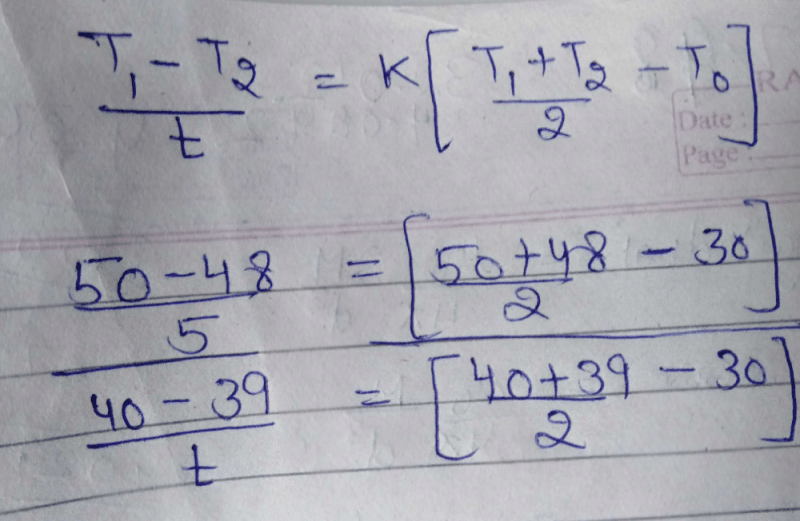Class 11 Exam > Class 11 Questions > Hey, I couldn't find the answer to this quest...
Start Learning for Free
Hey, I couldn't find the answer to this question "A body cools from 50•C to 48•Celsius in 5sec.how long will it take to cool from 40•C to 39•C? Surrounding temp. To be 30•c.?
Most Upvoted Answer
Hey, I couldn't find the answer to this question "A body cools from 50...


|
Explore Courses for Class 11 exam
|

|
Similar Class 11 Doubts
Hey, I couldn't find the answer to this question "A body cools from 50•C to 48•Celsius in 5sec.how long will it take to cool from 40•C to 39•C? Surrounding temp. To be 30•c.?
Question Description
Hey, I couldn't find the answer to this question "A body cools from 50•C to 48•Celsius in 5sec.how long will it take to cool from 40•C to 39•C? Surrounding temp. To be 30•c.? for Class 11 2025 is part of Class 11 preparation. The Question and answers have been prepared according to the Class 11 exam syllabus. Information about Hey, I couldn't find the answer to this question "A body cools from 50•C to 48•Celsius in 5sec.how long will it take to cool from 40•C to 39•C? Surrounding temp. To be 30•c.? covers all topics & solutions for Class 11 2025 Exam. Find important definitions, questions, meanings, examples, exercises and tests below for Hey, I couldn't find the answer to this question "A body cools from 50•C to 48•Celsius in 5sec.how long will it take to cool from 40•C to 39•C? Surrounding temp. To be 30•c.?.
Hey, I couldn't find the answer to this question "A body cools from 50•C to 48•Celsius in 5sec.how long will it take to cool from 40•C to 39•C? Surrounding temp. To be 30•c.? for Class 11 2025 is part of Class 11 preparation. The Question and answers have been prepared according to the Class 11 exam syllabus. Information about Hey, I couldn't find the answer to this question "A body cools from 50•C to 48•Celsius in 5sec.how long will it take to cool from 40•C to 39•C? Surrounding temp. To be 30•c.? covers all topics & solutions for Class 11 2025 Exam. Find important definitions, questions, meanings, examples, exercises and tests below for Hey, I couldn't find the answer to this question "A body cools from 50•C to 48•Celsius in 5sec.how long will it take to cool from 40•C to 39•C? Surrounding temp. To be 30•c.?.
Solutions for Hey, I couldn't find the answer to this question "A body cools from 50•C to 48•Celsius in 5sec.how long will it take to cool from 40•C to 39•C? Surrounding temp. To be 30•c.? in English & in Hindi are available as part of our courses for Class 11.
Download more important topics, notes, lectures and mock test series for Class 11 Exam by signing up for free.
Here you can find the meaning of Hey, I couldn't find the answer to this question "A body cools from 50•C to 48•Celsius in 5sec.how long will it take to cool from 40•C to 39•C? Surrounding temp. To be 30•c.? defined & explained in the simplest way possible. Besides giving the explanation of
Hey, I couldn't find the answer to this question "A body cools from 50•C to 48•Celsius in 5sec.how long will it take to cool from 40•C to 39•C? Surrounding temp. To be 30•c.?, a detailed solution for Hey, I couldn't find the answer to this question "A body cools from 50•C to 48•Celsius in 5sec.how long will it take to cool from 40•C to 39•C? Surrounding temp. To be 30•c.? has been provided alongside types of Hey, I couldn't find the answer to this question "A body cools from 50•C to 48•Celsius in 5sec.how long will it take to cool from 40•C to 39•C? Surrounding temp. To be 30•c.? theory, EduRev gives you an
ample number of questions to practice Hey, I couldn't find the answer to this question "A body cools from 50•C to 48•Celsius in 5sec.how long will it take to cool from 40•C to 39•C? Surrounding temp. To be 30•c.? tests, examples and also practice Class 11 tests.

|
Explore Courses for Class 11 exam
|

|
Signup for Free!
Signup to see your scores go up within 7 days! Learn & Practice with 1000+ FREE Notes, Videos & Tests.
























